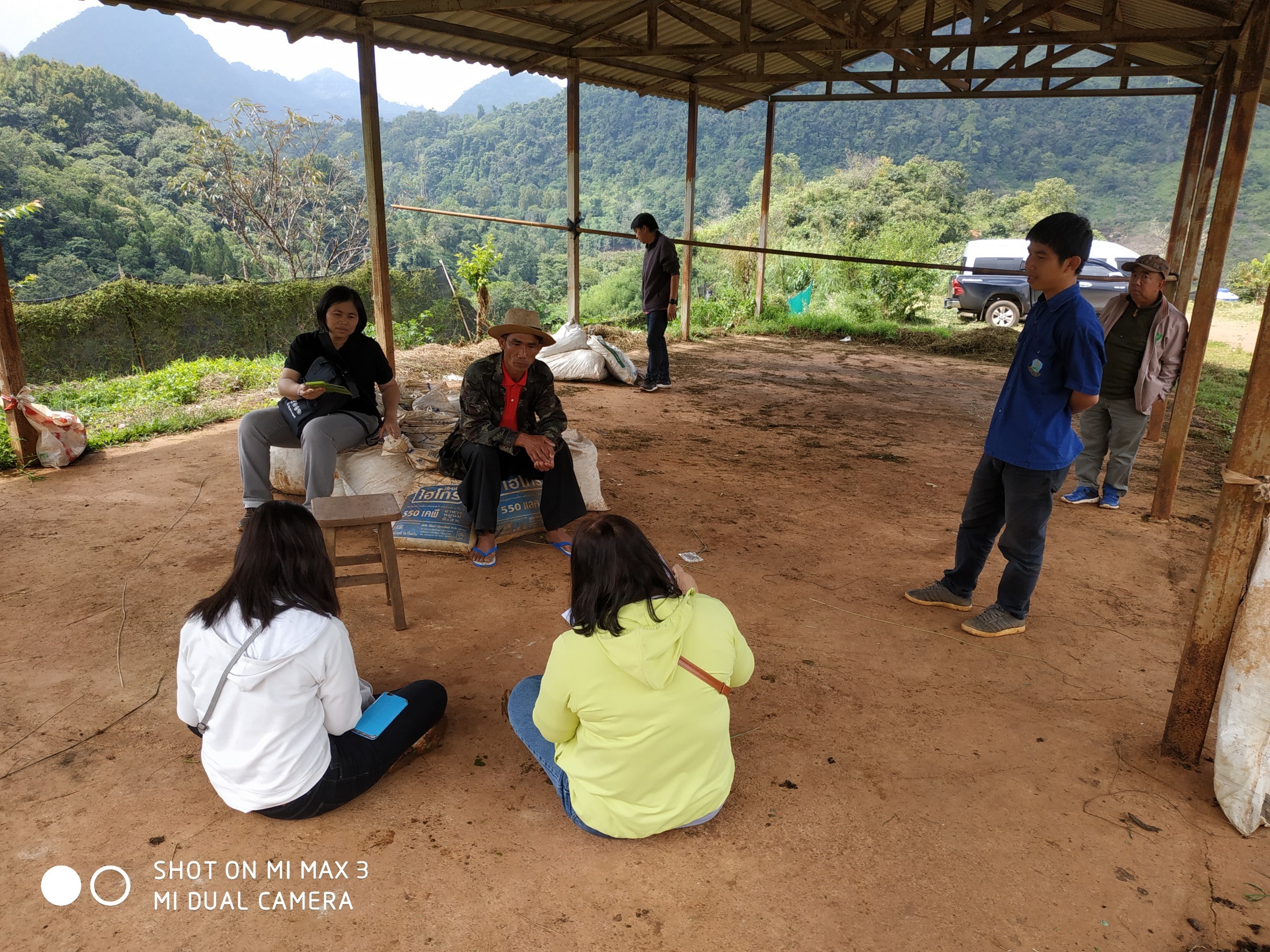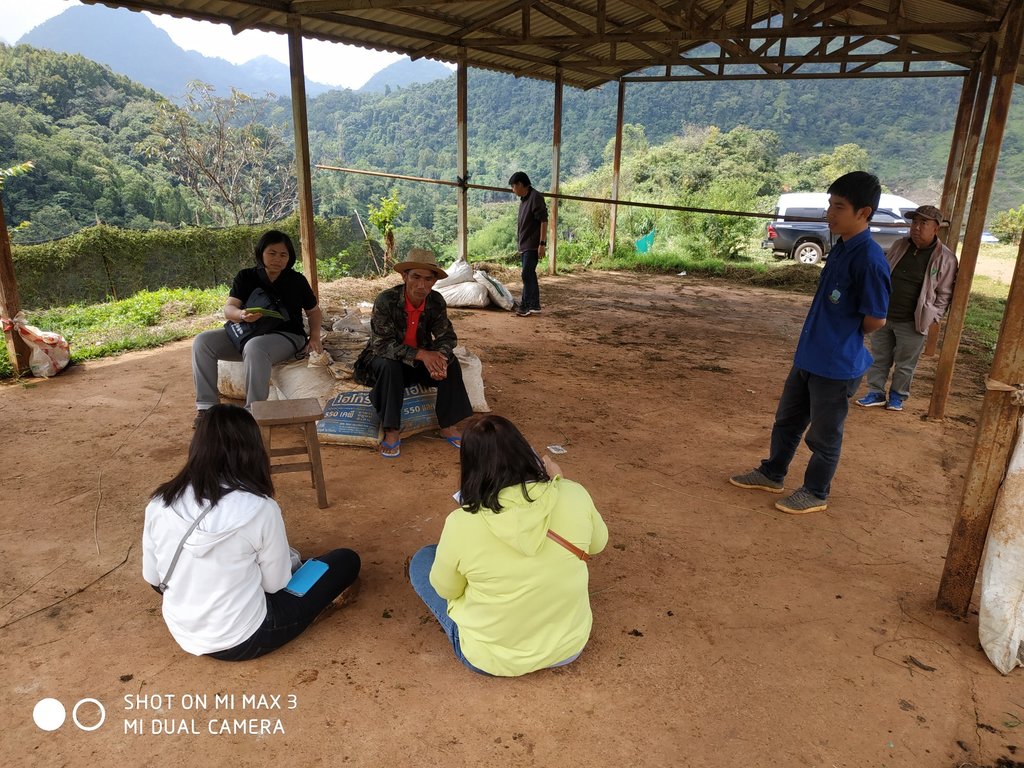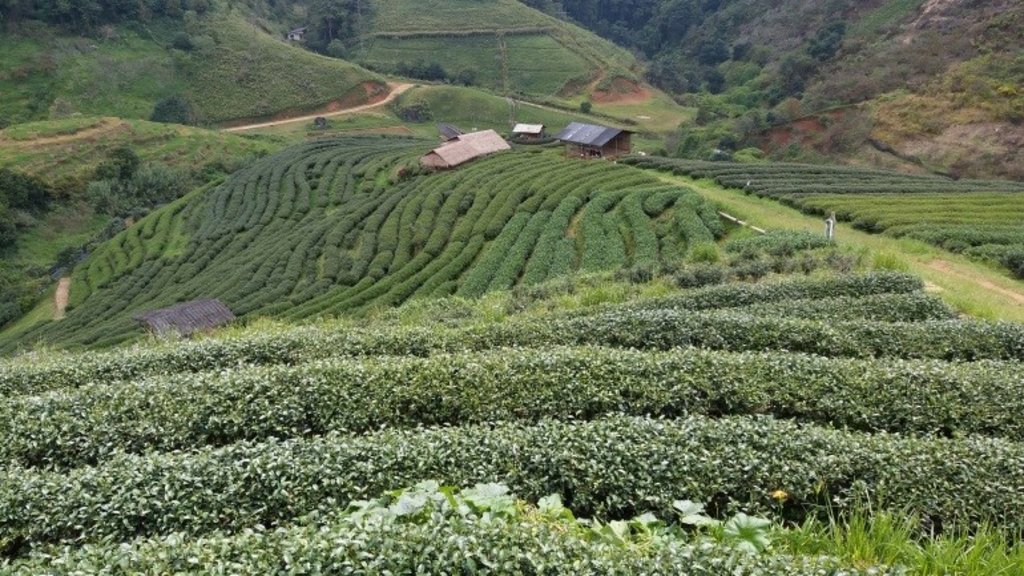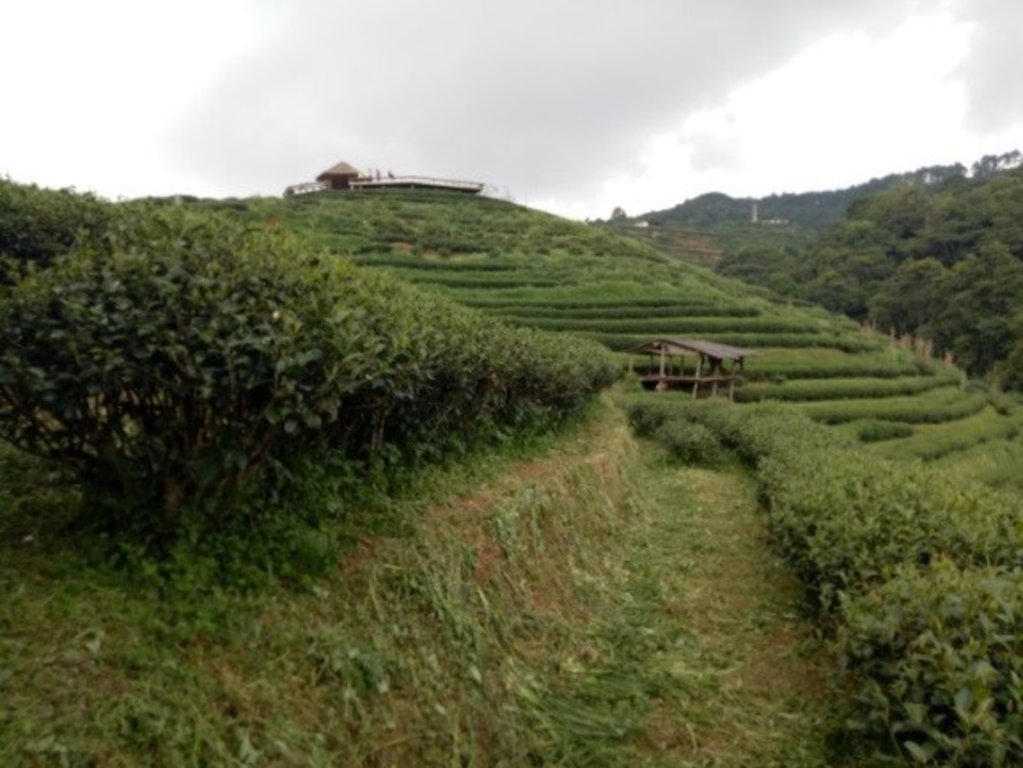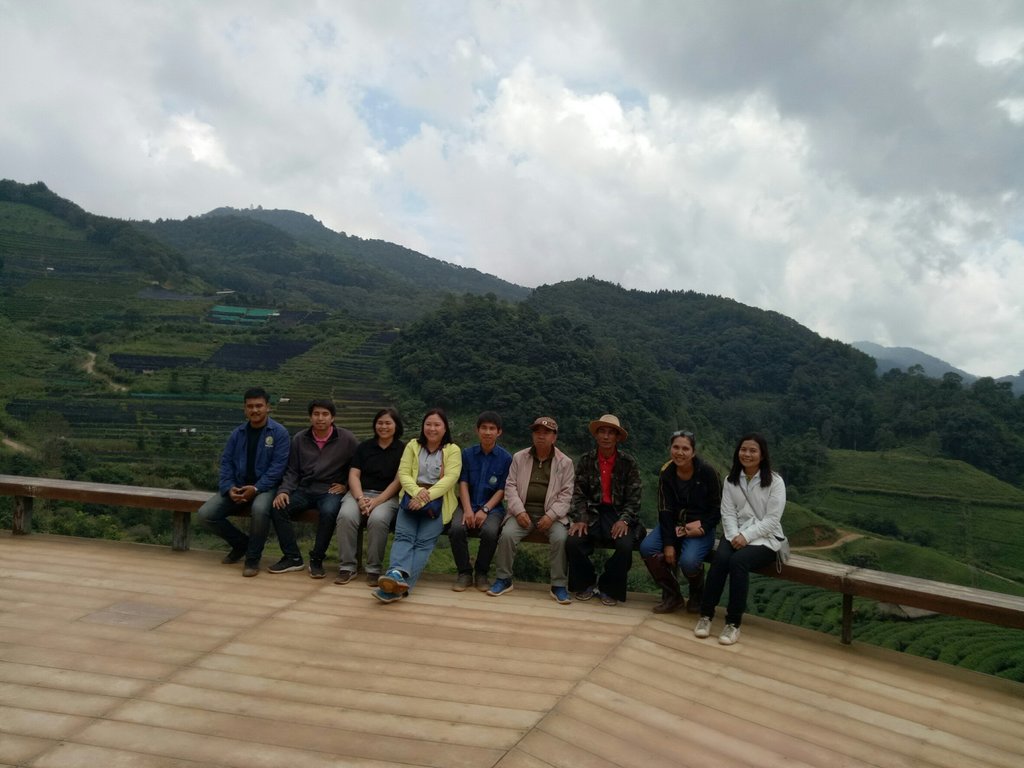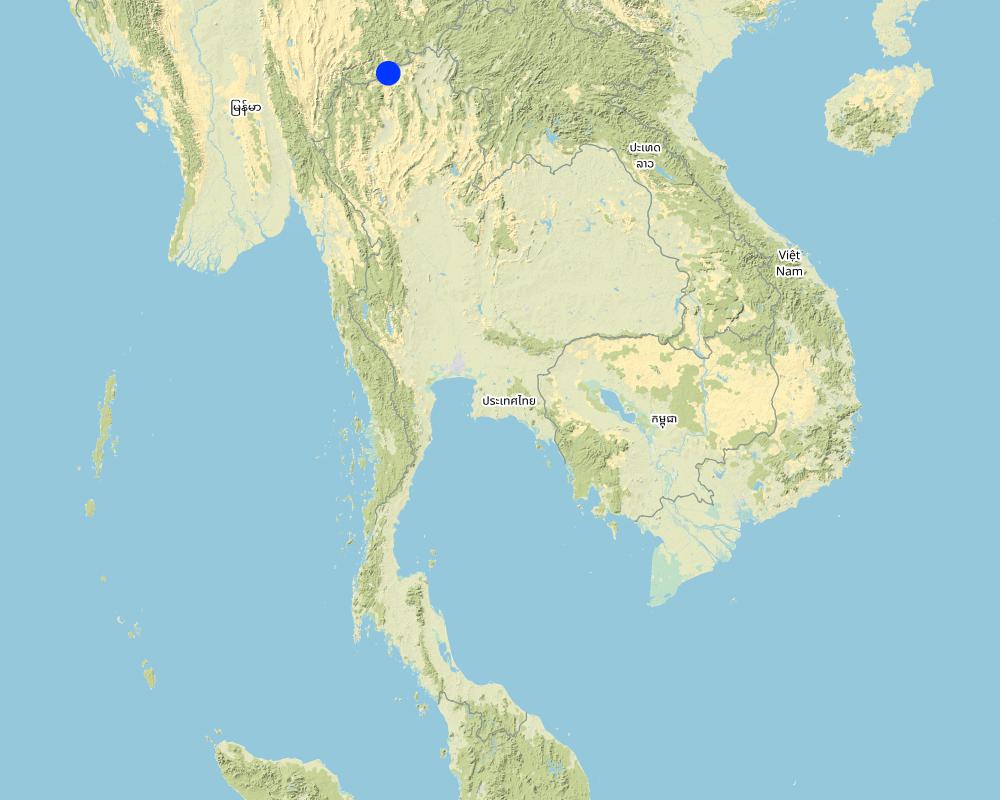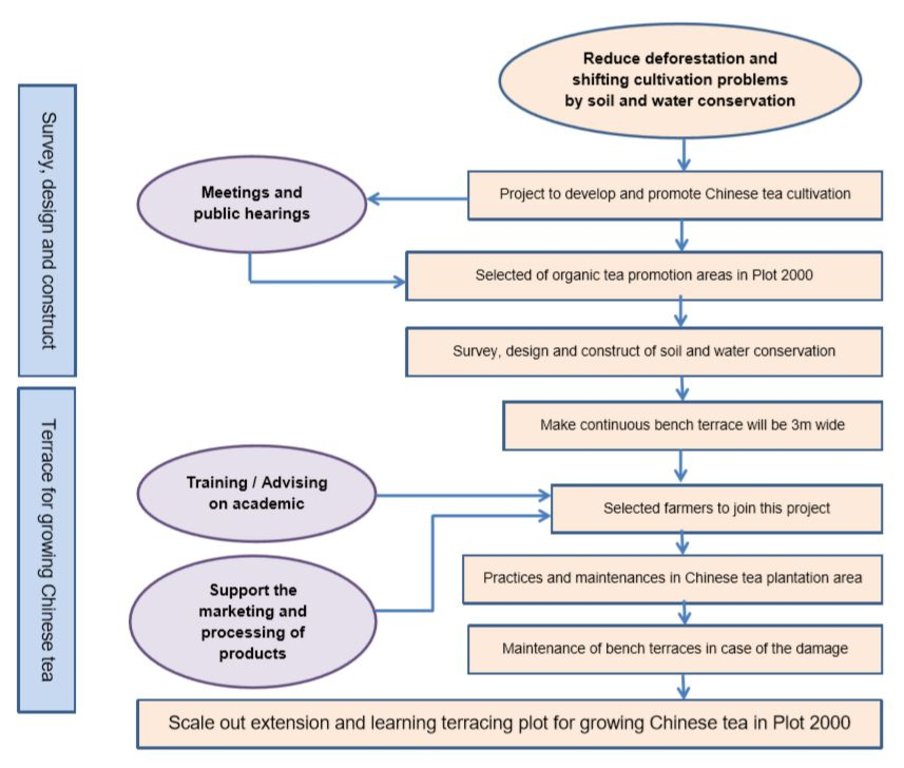Promotion of Organic Tea Production under Bench Terraces [Thailand]
- Creation:
- Update:
- Compiler: Pitayakon Limtong
- Editor: –
- Reviewers: Rima Mekdaschi Studer, William Critchley
Continuous bench terrace
approaches_4282 - Thailand
View sections
Expand all Collapse all1. General information
1.2 Contact details of resource persons and institutions involved in the assessment and documentation of the Approach
Key resource person(s)
co-compiler:
Tipvong Tanomkwan
1760 ต่อ 2235 / 0879172421
aoy.tvong.@gmail.com
Land Development Department
Pahotyothin Rd., Chatuchak, Bangkok 10900
Thailand
land user:
Mokngoen Jai
0658720601 / -
- / -
Palaung hill tribe, land user in Plot 2000
Mu 5, Khum village, Mae Ngon sub-district, Fang district, Chiang Mai province, 50110
Thailand
Tapangtong Werapong
0987488087 / -
- / -
Angkhang Royal Agricultural Station
Mu 5, Khum village, Mae Ngon sub-district, Fang district, Chiang Mai province, 50110
Thailand
Boonchoo Sontaya
- / -
- / -
Royal Project Land Development Center, Land Development Department
164 Mu 3, Chiang Mai-Fang Road, Don Kaeo subdistrict, Mae Rim district, Chiang Mai province, 50180
Thailand
Name of the institution(s) which facilitated the documentation/ evaluation of the Approach (if relevant)
Land Development Department (Land Development Department) - Thailand1.3 Conditions regarding the use of data documented through WOCAT
When were the data compiled (in the field)?
19/10/2018
The compiler and key resource person(s) accept the conditions regarding the use of data documented through WOCAT:
Yes
2. Description of the SLM Approach
2.1 Short description of the Approach
Promotion of continuous bench terraces for sustainable tea plantations in steep areas of the northern region highlands.
2.2 Detailed description of the Approach
Detailed description of the Approach:
The approach is to develop and promote sustainable agriculture on steep slopes by establishing continuous bench terraces. Under this system, hilltribe farmers can produce good quality Chinese tea, and send their product to a processing factory nearby, which will create stable and high incomes and raise the quality of life. This production/ conservation system aims also to reduce deforestation and shifting cultivation problems, which lead to the degradation of soil and land. As such, soil and water conservation in this upstream sloping highland should promote and encourage appropriate sustainable land management to preserve natural resources and the environment.
In the early stage, Angkhang Royal Agricultural Station initiated this project to develop and promote Chinese tea cultivation on steep land, with close cooperation from the Land Development Department (LDD) to design the continuous bench terraces instead of the cold-climate fruit trees, which had greatly deteriorated. Local officers had allocated land (without ownership) to Palaung hilltribe people who were selected and guaranteed by the community leader for their aptitude and ability to cultivate Chinese tea according to the Good Agricultural Practices (GAP) Guidelines, and set up a Chinese tea producers group at Plot 2000. Angkhang Royal Agricultural Station organized this programme and trained them and also arranged for some local officers to advise on soil management, fertilizer use, and disease and pest control. Vetiver grass planting was introduced to maintain the terrace and road edges; compost was produced to use for improving soil properties and reducing their production cost, and cultivation materials were supplied to all land users through disbursement under the management of Doi Angkhang Agricultural Cooperatives. Local officers also supported marketing through purchasing at the guaranteed price according to the quality of the tea, and set up tea processing factories in this area. The project encourages all land users to observe and maintain their tea bushes and the land around them. Currently all land users are aware of how to sustainably use and maintain their land and soil resources. Moreover, local officers advise how to repair bench terraces themselves; however, if the damage is serious, the LDD officers will come in to help them repair.
2.3 Photos of the Approach
General remarks regarding photos:
Data collection supports for mainstreaming and scaling-up of sustainable land management
2.4 Videos of the Approach
Comments, short description:
Tea plantation in soil and water conservation measure in steep areas
Date:
09/10/2018
Location:
Doi Ang Khang
Name of videographer:
Ms. Somjit Lertdisayawan / Ms. Tanomkwan Tipvong
Comments, short description:
Tea plantation farm
Date:
21/01/2016
Location:
Doi Angkhang
Name of videographer:
Pornthep Molee
Comments, short description:
Angkhang Royal Agricultural Station
39 เส้นทาง เรียนรู้ ทำดี “ตามรอยพ่อ”
Date:
15/03/2017
Location:
Angkhang Royal Agricultural Station
Name of videographer:
Royal Project Foundation, Ford Thailand
2.5 Country/ region/ locations where the Approach has been applied
Country:
Thailand
Region/ State/ Province:
Chiang Mai Province
Further specification of location:
Extension area for Chinese tea plantation (Farm 2000) at Angkhang Royal Agricultural Station, Mae Ngon Sub-district, Fang District,Chiang Mai Province
Comments:
Angkhang Royal Agricultural Station is the main agency to assist, support and encourage hilltribe farmers in protection and awareness of soil resources in this steep zone. Soil and water conservation measures have been used to solve the erosion problem, protect the environment, preserve the forest and enable land users to grow the Chinese tea in this area ("Farm 2000").
Map
×2.6 Dates of initiation and termination of the Approach
Indicate year of initiation:
1999
If precise year is not known, indicate approximate date when the Approach was initiated:
10-50 years ago
Comments:
Sustainable use of a steep area. Hill tribe farmers can utilize this continuous bench terrace land for tea plantation or other purposes for long time under GAP system.
2.7 Type of Approach
- project/ programme based
2.8 Main aims/ objectives of the Approach
The first objective is to enable hilltribe farmers, through suitable soil and water conservation measures, to produce good quality Chinese tea on the highland. The second objective is to create a stable income and raise the quality of life, where it is very important to ensure sustainable landuse without damaging natural resources and the environment. The third is to reduce forest encroachment problems in the highland and watershed areas of the northern region of Thailand.
2.9 Conditions enabling or hindering implementation of the Technology/ Technologies applied under the Approach
availability/ access to financial resources and services
- enabling
Angkhang Agricultural Cooperatives supported production factors to land users and cooperatives officers will monitor and evaluate this process.
institutional setting
- enabling
Land user network as cooperative of tea plantation group with cooperation in compost or organic fertilizers production
legal framework (land tenure, land and water use rights)
- enabling
Almost land users did not have right in land ownership, but they have right to use the allocated land, which these land are allocated by the Royal Project.
policies
- enabling
Government policy and Royal project supported the budget and implementation activities
land governance (decision-making, implementation and enforcement)
- enabling
Royal project and government agencies regulated land use planning and take care on soil and land management in this area.
knowledge about SLM, access to technical support
- enabling
The officers of Angkhang Royal Agricultural Station advise land users to manage soil and land, including tea production and process.
markets (to purchase inputs, sell products) and prices
- enabling
They have tea processing factories in this area.
other
- enabling
3. Participation and roles of stakeholders involved
3.1 Stakeholders involved in the Approach and their roles
- local land users/ local communities
All farmers belong to the hilltribe Palaung ethnic group.
All land users take care of bench terraces with advice from station officers.
- community-based organizations
Angkhang Royal Agricultural Station, The Royal Project
The station officers extend and promote the occupation, encourage and advise in technology transfer the technical matter and knowledge to farmers.
- teachers/ school children/ students
School children and students
Training course and study tour in the area
- local government
Several local government agencies are directly involved in this process, including officers from the station and the Royal Project.
The station officers extend and promote the occupation, encourage and advise the farmers in technical knowledge, support production facilities and processing factory.
- national government (planners, decision-makers)
Administrative officers in department and ministry level
Making decisions and creating policy
3.2 Involvement of local land users/ local communities in the different phases of the Approach
| Involvement of local land users/ local communities | Specify who was involved and describe activities | |
|---|---|---|
| initiation/ motivation | interactive | Angkhang Royal Agricultural Station created continuous bench terraces as a soil and water conservation measure in the former degraded cold-climate fruit tree plot. They informed all land users about land allocation and zoning for suitable economic crops and trees, including Chinese tea in Plot 2000. |
| planning | interactive | Almost all land users (Palaung hilltribe) have been allocated land for planting Chinese tea with good agricultural practices (GAP) system in Plot 2000. |
| implementation | none | The LDD has been responsible for conducting soil and land survey, designing and constructing soil and water conservation measures, with close collaboration with Angkhang Royal Agricultural Station. |
| monitoring/ evaluation | interactive | All Palaung hilltribe land users in this area have to maintain/repair the bench terraces in their allocated land. |
3.3 Flow chart (if available)
Description:
Flow chart Operating procedures of bench terrace:
1. The organic Chinese tea plantation project is emphasized to promote and develop career of hilltribe people around the area of Angkhang Royal Agricultural Station to reduce forest encroachment and shifting cultivation and encourage them to use the land in a sustainable way with stable and high income.
2. Angkhang Royal Agricultural Station has selected the area of old cold-climate crops where soil has deteriorated; the station officers need to reshape the land and construct suitable conservation measures in this sloping area.
3. In 1999, Land Development Department (LDD) supported in the survey, design and construction of soil and water conservation measures as continuous bench terraces. The distance between two terraces and the vertical interval (VI) depend on the slope of the area, but the cultivation area of each terrace will be 3m wide.
4. The Angkhang Royal Agricultural Station has selected farmers to join this project by considering their aptitude, ability and opportunity for further development in organic Chinese tea plantation. Almost all land users have been approved by community leaders to practice and implement following the instruction from extension officers.
5. All selected land users should practice and maintenance as recommended by station officers. In planting tea, farmers will dig a small furrow along the terrace around 30cm deep and 30cm wide. Tea seedlings will be planted in the furrow with a spacing of 40-50 cm between trees (around 2,000 plants/rai). Surface soil around these tea seedlings will be mulched to maintain suitable soil moisture.
6. Farmers will produce organic Chinese tea so they need to avoid applying chemical fertilizers and other chemical substances, but limit the use only to natural materials. Compost is applied at a rate of 2 kg/tree along both sides of the tea canopy, and incorporated about 15 cm below the soil surface. This compost rate may be applied 3 times a year.
7. The Chinese tea is usually harvested from April to December, and will receive nourishment/maintenance ( January-March). At present, the No. 12 variety has an average yield of 800 kg/rai, with some 5-6 harvests a year, while the soft stem variety has an average yield of 600 kg/rai, with some 4-5 harvests a year. The station has received a budget from the Taiwanese government and the Institute of Highland Area Development to support the processing factory building, machinery and necessary techniques.
8. Maintenance of damaged bench terraces: all land users will repair by themselves in the dry season. In the serious case of erosion, the LDD will support such maintenance. In addition, vetiver grass is planted to strengthen the edge of the terraces.
Author:
Ms.Tanomkwan Tipvong
3.4 Decision-making on the selection of SLM Technology/ Technologies
Specify who decided on the selection of the Technology/ Technologies to be implemented:
- all relevant actors, as part of a participatory approach
Explain:
-
Specify on what basis decisions were made:
- evaluation of well-documented SLM knowledge (evidence-based decision-making)
- Policies and legal measures
4. Technical support, capacity building, and knowledge management
4.1 Capacity building/ training
Was training provided to land users/ other stakeholders?
Yes
Specify who was trained:
- land users
If relevant, specify gender, age, status, ethnicity, etc.
Both male and female
Form of training:
- farmer-to-farmer
- demonstration areas
Form of training:
- Mmonthly meeting
Subjects covered:
Implementation activities, how to solve some problems, maintain and repair conservation measure, vetiver grass plantation and others
Comments:
-
4.2 Advisory service
Do land users have access to an advisory service?
Yes
Specify whether advisory service is provided:
- on land users' fields
- at permanent centres
Describe/ comments:
-
4.3 Institution strengthening (organizational development)
Have institutions been established or strengthened through the Approach?
- yes, greatly
Specify the level(s) at which institutions have been strengthened or established:
- local
Describe institution, roles and responsibilities, members, etc.
All land users (from the Palaung hilltribe) have been selected as members to promote and implement organic Chinese tea plantation with their awareness to maintain and take care of conservation measures for sustainable use of this land.
Specify type of support:
- financial
- budget in repair structure
Give further details:
The Angkhang station gives a support budget to repair the bench terrace about 500 baht per rai.
4.4 Monitoring and evaluation
Is monitoring and evaluation part of the Approach?
Yes
Comments:
Angkhang Royal Agricultural Station set up a monitoring and evaluation programme for the Chinese tea cultivation under bench terraces.
If yes, is this documentation intended to be used for monitoring and evaluation?
Yes
Comments:
-
4.5 Research
Was research part of the Approach?
No
5. Financing and external material support
5.2 Financial/ material support provided to land users
Did land users receive financial/ material support for implementing the Technology/ Technologies?
Yes
If yes, specify type(s) of support, conditions, and provider(s):
LDD support with the supply of vetiver grass slips and technology to maintain the terrace including support the budget to repair terraces at 500 baht per rai per year.
5.3 Subsidies for specific inputs (including labour)
- labour
| To which extent | Specify subsidies |
|---|---|
| partly financed | Maintain and repair budget around 500 baht per rai. |
If labour by land users was a substantial input, was it:
- voluntary
Comments:
-
5.4 Credit
Was credit provided under the Approach for SLM activities?
Yes
Specify conditions (interest rate, payback, etc.):
No interest
Specify credit providers:
Cooperatives of Angkaung Royal Agricultural Station support in production materials
Specify credit receivers:
All land users are members of this cooperatives.
5.5 Other incentives or instruments
Were other incentives or instruments used to promote implementation of SLM Technologies?
No
6. Impact analysis and concluding statements
6.1 Impacts of the Approach
Did the Approach help land users to implement and maintain SLM Technologies?
- No
- Yes, little
- Yes, moderately
- Yes, greatly
Almost land users are good in maintaining and repairing this terrace system.
Did the Approach improve coordination and cost-effective implementation of SLM?
- No
- Yes, little
- Yes, moderately
- Yes, greatly
They collaborate closely with local officers.
Did the Approach improve knowledge and capacities of land users to implement SLM?
- No
- Yes, little
- Yes, moderately
- Yes, greatly
They cannot construct this terrace by themselves, but can maintain and repair the damaged areas. They know and understand the benefit and effectiveness of this measure.
Did the Approach improve issues of land tenure/ user rights that hindered implementation of SLM Technologies?
- No
- Yes, little
- Yes, moderately
- Yes, greatly
They cannot have right in land ownership but they have rights in land tenure and utilize this land for Chinese tea in Plot 2000.
Did the Approach lead to more sustainable use/ sources of energy?
- No
- Yes, little
- Yes, moderately
- Yes, greatly
This bench terrace and other land management practices are firmly sustainable for Chinese tea production.
6.2 Main motivation of land users to implement SLM
- increased production
Harvest of Chinese tea 5-6 times/year and generate more income for land users.
- reduced land degradation
This bench terrace system is effective in reducing soil erosion, runoff and preserving soil fertility and quality.
- affiliation to movement/ project/ group/ networks
Angkaung Royal Agriculture station set up project of promotion and development.
6.3 Sustainability of Approach activities
Can the land users sustain what has been implemented through the Approach (without external support)?
- uncertain
If no or uncertain, specify and comment:
All land users need to work within the guideline of this project, maintain and repair the terrace, take care of Chinese tea until the period of harvest, and also soil and land fertility improvement.
6.4 Strengths/ advantages of the Approach
| Strengths/ advantages/ opportunities in the land user’s view |
|---|
| The continuous bench terrace is a highly effective measure to slow down runoff, and thus reduces soil erosion. |
| This system would reduce the amount of fertilizer application, as organic matter and plant nutrients still stay in the sloping area. |
| All land users can produce more agricultural products, thus will receive more income. |
| Strengths/ advantages/ opportunities in the compiler’s or other key resource person’s view |
|---|
| The bench terrace increases the amount of water to store in the soil, while the excessive amount of rain would gradually drain through the waterway. |
| This technology would reduce the amount of fertilizer application as it prevents plant nutrients from escaping from the area. |
| All land users can improve their life quality from increasing agricultural products/income. |
6.5 Weaknesses/ disadvantages of the Approach and ways of overcoming them
| Weaknesses/ disadvantages/ risks in the land user’s view | How can they be overcome? |
|---|---|
| The cost for constructing continuous bench terraces is very high. | It is possible only when the government and local officers support these activities. |
| The system needs expert in design and implementation. | Local government officers (LDD) support and perform these activities. |
| When the structure of bench terraces is damaged. | Local government officers (LDD) will help in doing the repair. |
| Weaknesses/ disadvantages/ risks in the compiler’s or other key resource person’s view | How can they be overcome? |
|---|---|
| The cost for constructing bench terraces is very high, heavy machines are needed. | Government and local officers support these activities. |
| The system needs expert in doing the design and implementation. | Local government officers (LDD) support and perform these activities. |
| When the structure of bench terraces is damaged by heavy rain, runoff and other events. | Local government officers (LDD) support its reparation. |
7. References and links
7.1 Methods/ sources of information
- field visits, field surveys
3
- interviews with land users
1
- interviews with SLM specialists/ experts
2
- compilation from reports and other existing documentation
1
7.2 References to available publications
Title, author, year, ISBN:
-
Available from where? Costs?
-
7.3 Links to relevant information which is available online
Title/ description:
การทำขั้นบันไดดินเพื่อการอนุรักษ์ดินและน้ำในพื้นที่ป่าต้นน้ำลำธาน (ความลาดชัน 35-60%)
URL:
http://www.dnp.go.th/watershed/ ส่วนอำนวยการ/จัดทำระบบอนุรักษ์ดินและน้ำ โครงการทำขั้นบันไดดิน.pdf
Links and modules
Expand all Collapse allLinks
No links
Modules
No modules


